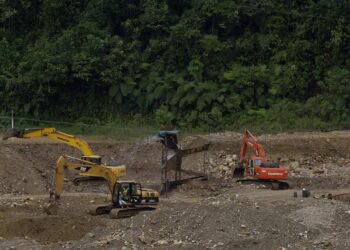An Amazon conservation initiative has detected a rapid growth in illegal gold mining sites at a natural park and ecological marvel in Ecuador, showing once again how miners are pillaging the country’s most far-flung regions.
Between 2019 and 2022, 222 illegal campsites were detected at Podocarpus National Park, located in the southern provinces of Loja and Zamora Chinchipe near the border with Peru, the Monitoring of the Andean Amazon Project (MAAP) reported in January.
These camps are distributed in three separate areas: Dos Camas, where illegal mining sites went from covering less than a hectare in 2019 to close to five hectares in 2022; San Luis, which saw its affected area more than triple to 11.7 hectares in 2022; and La Aida, which has nine hectares of illegal mines.
Additionally, most of the gold mining there is done through undercut mining, according to MAAP, which can worsen environmental damage through soil erosion, destruction of water resources, and releasing toxic waste.
Podocarpus is home to a wide range of endemic species, including the puma, the dwarf deer, the Andean wolf, hummingbirds, parrots, and toucans.
SEE ALSO: Illegal Mining Spreads to Furthest Reaches of Amazon in Ecuador
Ecuador has long been beleaguered by illegal mining. The town of Zamura, capital of El Oro province and just 100 kilometers from Podocarpus, has been so badly affected by undercut mining that sinkholes are forming. One sinkhole in December 2021 caused three houses to collapse in Zamuro, and a state of emergency was declared soon after.
Ecuador’s Minister of Energy and Non-Renewable Resources Juan Carlos Bermeo explained at an event on January 6 last year that “illegal mining had taken over the city’s subsoil” and that measures taken to help Zaruma “will not show results in the short-term.”
InSight Crime Analysis
While illegal mining in Podocarpus remains modest, its rapid growth confirms that Ecuador’s most remote regions are the new epicenters for illegal mining.
Besides the nearby province of El Oro, Ecuador’s easternmost province, Napo, has been a focal point for illegal miners. According to MAAP, mining there has grown by 21,000% in two decades to reach 557 hectares affected in 2020.
The Jatunyaku and Napo rivers in this province, which includes part of the Amazon rainforest, have been severely polluted. A 2020 government report revealed that roughly 90% of the rivers tested in Napo displayed toxicity, pointing to “chronic contamination” that threatens wildlife and local communities.
Another area affected by illegal mining is the province of Azuay, bordering Loja and Zamora. There, miners extract illegal gold from the rivers to such an extent that some towns have run out of drinking water.
The difficulty of access to these areas has hampered a security response. It also hampers the reporting of mining activities and subsequent safety measures.
While mining in Podocarpus Park does not compare to the scale of El Oro or Napo, it could rapidly catch up. Podocarpus is close to the border with Peru, which is a common route for the exit of illegally mined gold from Ecuador, according to Minister of Energy and Mines, Xavier Vera.

